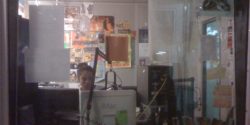In the provocative piece, WNYU, New York is “Almost Public Radio,” radio veteran Ken Mills posits that college radio station WNYU at New York University (see my 2008 tour) falls into the category of “almost public radio.”
Mills argues that stations in this category “copy public radio’s style, represent themselves as a public trust and/or are staffed by people who, frankly, would rather be working in public radio.”
I’m struck by his assertion that college radio stations like WNYU have public radio aspirations and somehow see their stations as lesser than public radio. This is a bold assumption that works to diminish college radio’s history and inherent strengths.
Of course there may be college radio participants with public radio dreams or commercial radio dreams or community radio dreams, but there are many who are focused on the day-to-day work, fun, and educational aspects of college radio.
Student-run college radio stations existed prior to public radio and a hallmark of many of them is creative freedom, student control, and adventurous programming. College radio stations pioneered many technological and programming innovations (with limited budgets and mainly volunteer staffs) that were later adopted by public radio stations, such as online streaming (credit to WXYC and WREK – see my tour) and international live remote broadcasts (shout out to KFJC, where I volunteer). Many music-oriented public radio stations took cues from their college radio forebears and some air underground music that first got airplay on college radio stations.
While there is crossover, with some public radio stations incorporating student staff (as I saw during my tour of Fordham University’s WFUV) and some college radio stations seeking out public funding; for the most part I see college radio as one category of stations and public radio as another.
A huge difference is budget and staffing. Despite a lower budget and smaller staff than public radio stations, Mills critiques WNYU for its small listening audience relative to its FM signal strength, saying, “Despite this capacity, WNYU has only a few thousand estimated weekly listeners. Except for the students who work there, the station is unknown to most people who live in the city.”
He speculates that, “In general, college stations have the smallest budgets of any noncommercial media type. This limits the opportunities for participating students.” While small budgets can lead to numerous challenges, I’m continually amazed by what college radio stations accomplish. Creativity often flourishes in the absence of monetary resources, with volunteer DJs and staff putting in countless hours (sometimes putting grades and graduation in jeopardy) for the love of radio.
Mills goes on to critique WNYU’s programming, stating that,
Another factor that may be limiting WNYU’s potential is their programming. To use a common phrase, WNYU is ‘too hip for the room.’ When the ‘room’ is New York City, there will be difficulty drawing a substantial audience. The good news is that WNYU is programmed 100% by students. The bad news is these students are probably the only listeners.
Ouch. Mills points to some intriguing programming, but dismisses it as having “very limited interest.”
I think that it’s wonderful to have a range of non-commercial radio stations on the dial, including well-funded (and not-so-well funded) public radio stations, grassroots community stations, tiny low power FM stations, high school radio in many forms, and the wide range of college radio stations. There is a place for unusual and niche programming on college radio. And that’s what keeps me glued to my FM dial.
More College Radio News
Radio Classes
Profiles
- After Hours: The Faces Behind the Radio (The Shield, University of Southern Indiana)
- Manchester Community College Radio Station Celebrates 10 Years (Journal Inquirer)
Budget
- Campus Radio Asserts Provincial Cuts will Reduce Job Opportunities and Services to Students (The National Campus and Community Radio Association)
Awards and Accolades
- Another “Best of” Nomination for WPSC (Radio Ink)
- UNK Students Named as Finalists for College Media Awards (Net Nebraska)
Alumni
- Dyana Williams Biography (The History Makers)
Programming
- Campus-Based Podcasts (Inside Higher Ed)
- WSBU-FM Staffers from St. Bonaventure Make Connections in Georgia, the Site of Sunday’s Big Game (TAPinto)
- Third Season of Bloomfield’s Health Beat Radio Show (TAPinto)
History
- Time Marches On: A Look Back at L’Amour and Metal History (Brooklyn Daily Eagle)
Launches
- Manhattan College’s Radio WRCM Makes a Comeback (The Quadrangle)
License Sales
- Antioch College to Sell Public Radio Station WYSO to Community Group (Dayton Daily News)
- Antioch College Establishing WYSO as Independent Public Radio Station (ABC 22)
- WYSO to Become an Independent Public Radio Station (Dayton Business Journal)
- Quinnipiac AM Community Radio Station to Be Shut Down in June (UConn Daily Campus)



